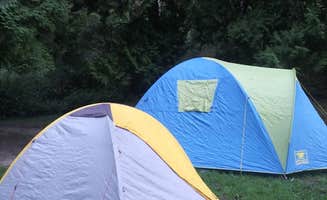Dispersed camping near Hurricane, West Virginia primarily concentrates in the Wayne National Forest across the Ohio border. The forest spans over 244,000 acres with elevations ranging from 600 to 1,250 feet throughout the Appalachian foothills. Seasonal conditions vary significantly, with summer temperatures averaging 75-85°F and winter temperatures frequently dropping below freezing, creating distinct camping environments throughout the year.
What to do
Fishing opportunities: Several small lakes and ponds populate Hanging Rock Recreation Site where anglers can find relative solitude. "I found a spot quickly and had 2 entire ponds to myself," notes camper Rob G., who appreciated the water access despite some noise issues during daylight hours.
ATV trail riding: Motor-powered recreation forms the core activity at the OHV areas, with trails designed for specific vehicle sizes. "The Hanging Rock Recreation area features tons of well kept ATV trails for motor bikes or quads (max width allowed is 50 inches)," explains Lucille W., who visited the area while conducting wildlife research.
Wildflower observation: Spring and early summer bring abundant native plant displays to the forest floor. Lucille W. notes, "Along and just off the trails were tons of gorgeous wildflowers like trilliums, violets, showy orchids, and more!" Many species reach peak bloom in April and May when temperatures moderate.
What campers like
Sunrise views: Early morning light creates memorable moments for those camping near Hanging Rock Recreation Area. Rob G. describes his experience: "Awesome morning sunrise!" after enduring some noise challenges earlier in his stay, demonstrating the rewarding aspects that balance out potential drawbacks.
Secluded locations: Finding quieter spots away from main recreation areas provides more peaceful camping experiences. "We found the Sand Hill Trail head and pitched camp not too far from where we parked," explains Marisa A., who discovered this area after relocating from a busier trailhead.
Wildlife viewing: The diverse forest habitat supports varied wildlife, particularly in early morning and evening hours. Campers frequently report sightings of white-tailed deer, wild turkeys, and various bird species, particularly in less disturbed areas of the forest.
What you should know
Navigation challenges: The patchwork nature of public and private land requires thorough preparation. Sand Hill Trailhead visitor Marisa A. advises, "We arrived late at night wishing we had better cell reception and a paper map of the National Forest. We were grateful to have the Dyrt's info downloaded on my chromebook."
Variable site conditions: Cleanliness and site quality fluctuate significantly between locations and seasons. David B. warns about Hanging Rock: "Not the greatest place to camp. Trash in most places, people partying all the time. Watch for needles if you go! Be sure to wear shoes."
Limited amenities: Basic facilities exist at some locations, but campers should expect primitive conditions. Jay S. notes about their overnight experience: "We stayed in the parking lot as it was getting dark and didn't know if there were any place to turn our rv around. Very quiet night and were visited by fireflies which was awesome."
Tips for camping with families
Safety considerations: Some dispersed sites present potential safety concerns that families should evaluate carefully. Timbre Ridge Lake offers more secluded camping options away from the higher-traffic OHV areas, potentially providing a quieter environment for families with children.
Evening activity planning: Night experiences vary dramatically by location. Harley S. cautions about one location: "Me and my family were here for 2 days and everything about it especially at night it's really scary would not recommend."
Wildlife education opportunities: The forest provides natural classroom experiences for children interested in ecology. Spring and early summer camping coincides with peak wildflower blooms, offering educational identification opportunities for families with plant guidebooks.
Tips from RVers
Parking limitations: Many dispersed areas lack formal designated parking or turnaround space for larger vehicles. Jay S. shares this practical experience: "We stayed in the parking lot as it was getting dark and didn't know if there were any place to turn our rv around."
Road conditions: Forest Service roads vary significantly in quality and maintenance levels. Most access routes to dispersed camping require high-clearance vehicles, with some becoming impassable after heavy rainfall without 4WD capability.
Size restrictions: Few areas accommodate larger recreational vehicles. Small to medium-sized camper vans and truck campers find more suitable options than full-sized motorhomes or travel trailers throughout the Wayne National Forest dispersed camping areas.


